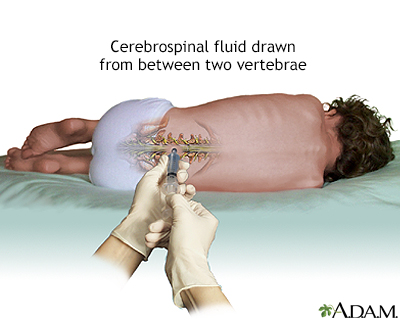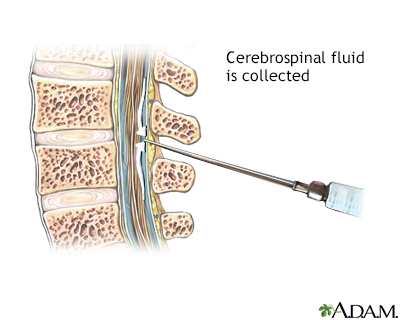CSF analysis
Cerebrospinal fluid analysis
Cerebrospinal fluid (CSF) analysis is a group of laboratory tests that measure chemicals in the cerebrospinal fluid. CSF is a clear fluid that surrounds and protects the brain and spinal cord. The tests may look for proteins, sugar (glucose), and other substances.
Images


I Would Like to Learn About:
How the Test is Performed
A sample of CSF is needed. A lumbar puncture, also called a spinal tap, is the most common way to collect this sample. Less common ways to take a fluid sample include:
- Cisternal puncture
- Removal of CSF from a tube that is already in the CSF, such as a shunt, ventricular drain, or pain pump
- Ventricular puncture
After the sample is taken, it is sent to the laboratory for evaluation.
Your health care provider will ask you to lie flat for at least one hour after the lumbar puncture. You may develop a headache after the lumbar puncture. If it happens, fluids and drinking caffeinated beverages such as coffee, tea or soda may help.
How to Prepare for the Test
Your provider will tell you how to prepare for lumbar puncture. Make sure to let them know all of the medicines you are taking in case any adjustment is needed.
Why the Test is Performed
Analysis of CSF can help detect certain conditions and diseases. All of the following can be, but are not always, measured in a sample of CSF:
- Antibodies and DNA of common viruses
- Bacteria (including that which causes syphilis, using a VDRL test)
- Cell count
- Chloride
- Cryptococcal antigen
- Glucose
- Glutamine
- Lactate dehydrogenase
- Oligoclonal banding to look for specific proteins
- Myelin basic protein
- Total protein
- Whether there are cancerous cells present (CSF cytology)
- Opening pressure
Normal Results
Normal results include:
- Antibodies and DNA of common viruses: None
- Bacteria: No bacteria grows in a lab culture
- Cancerous cells: No cancerous cells present
- Cell count: 0 to 5 white blood cells (all mononuclear) and 0 red blood cells
- Chloride: 110 to 125 mEq/L (110 to 125 mmol/L)
- Fungus: None
- Gamma globulin: 3% to 12% of the total protein
- Glucose: 50 to 80 mg/dL or 2.77 to 4.44 mmol/L (or greater than two-thirds of blood sugar level)
- Glutamine: 6 to 15 mg/dL (410.5 to 1,026 micromol/L)
- Lactate dehydrogenase: less than 40 U/L
- Oligoclonal bands: 0 or 1 bands that are not present in a matched serum sample
- Protein: 15 to 60 mg/dL (0.15 to 0.6 g/L)
- Opening pressure: 70 to 180 mm of water
- Myelin basic protein: Less than 4ng/mL
Normal value ranges may vary slightly among different laboratories. Talk to your provider about the meaning of your specific test results.
The examples above show the common measurements for results for these tests. Some laboratories use different measurements or may test different specimens.
What Abnormal Results Mean
An abnormal CSF analysis result may be due to many different causes, including:
- Cancer
- Encephalitis (such as Herpes simplex, West Nile, and Eastern Equine Encephalitis virus)
- Hepatic encephalopathy
- High blood sugar (hyperglycemia)
- Infection
- Inflammation
- Reye syndrome
- Meningitis due to bacteria, fungus, tuberculosis, or a virus
- Multiple sclerosis (MS)
- Alzheimer disease
- Pseudotumor cerebrii
- Normal pressure hydrocephalus
Related Information
CSF cell countCerebrospinal fluid (CSF) culture
CSF total protein
CSF glucose test
CSF-VDRL test
CSF coccidioides complement fixation test
CSF oligoclonal banding
Lactate dehydrogenase test
Cytologic evaluation
Loss of brain function - liver disease
Reye syndrome
Meningitis
References
Euerle BD. Spinal puncture and cerebrospinal fluid examination. In: Roberts JR, Custalow CB, Thomsen TW, eds. Roberts and Hedges' Clinical Procedures in Emergency Medicine and Acute Care. 7th ed. Philadelphia, PA: Elsevier; 2019:chap 60.
Rosenberg GA. Brain edema and disorders of cerebrospinal fluid circulation. In: Jankovic J, Mazziotta JC, Pomeroy SL, Newman NJ, eds. Bradley and Daroff's Neurology in Clinical Practice. 8th ed. Philadelphia, PA: Elsevier; 2022: chap 88.
Schnapp BH, Jewell C. Central nervous system infections. In: Walls RM, ed. Rosen's Emergency Medicine: Concepts and Clinical Practice. 10th ed. Philadelphia, PA: Elsevier; 2023:chap 95.
BACK TO TOPReview Date: 4/29/2023
Reviewed By: Joseph V. Campellone, MD, Department of Neurology, Cooper Medical School of Rowan University, Camden, NJ. Review provided by VeriMed Healthcare Network. Also reviewed by David C. Dugdale, MD, Medical Director, Brenda Conaway, Editorial Director, and the A.D.A.M. Editorial team.

Health Content Provider
06/01/2025
|
A.D.A.M., Inc. is accredited by URAC, for Health Content Provider (www.urac.org). URAC's accreditation program is an independent audit to verify that A.D.A.M. follows rigorous standards of quality and accountability. A.D.A.M. is among the first to achieve this important distinction for online health information and services. Learn more about A.D.A.M.'s editorial policy, editorial process and privacy policy. A.D.A.M. is also a founding member of Hi-Ethics. This site complied with the HONcode standard for trustworthy health information from 1995 to 2022, after which HON (Health On the Net, a not-for-profit organization that promoted transparent and reliable health information online) was discontinued. |
The information provided herein should not be used during any medical emergency or for the diagnosis or treatment of any medical condition. A licensed medical professional should be consulted for diagnosis and treatment of any and all medical conditions. Links to other sites are provided for information only -- they do not constitute endorsements of those other sites. © 1997- 2025 A.D.A.M., a business unit of Ebix, Inc. Any duplication or distribution of the information contained herein is strictly prohibited.
